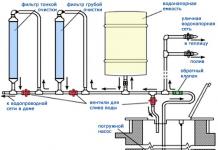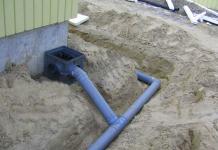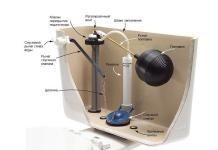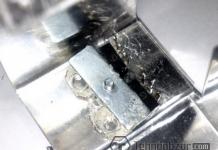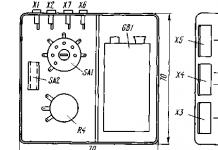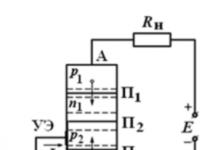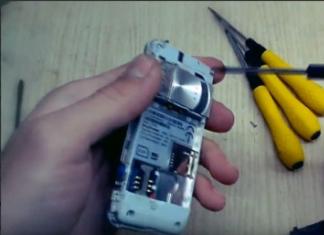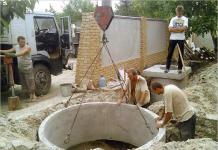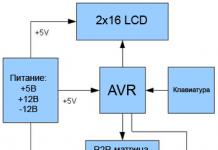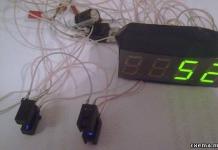According to the principle of operation, septic tanks made of concrete rings are divided into two types - single-chamber and multi-chamber (septic tanks for 2-3 wells).
- Single-chamber ones perform the function of simple drives, from which contents are periodically pumped out.
- Multi-chamber septic tanks are a kind of treatment facilities, since they separate wastewater into fractions.
The principle of operation of a septic tank for 2 wells
- First, a solid fraction is deposited at the bottom of the first chamber.
- As it fills, the liquid fraction overflows into the second chamber.
- There, heavy particles penetrating from the first chamber settle, and completely clarified wastewater, devoid of solid impurities, flows into the third chamber. This chamber contains filters through which the liquid passes before going into the ground.
The design and layout of a septic tank made of concrete rings for two or more wells will be discussed in more detail below.
Any structure takes up space and requires resources, so, first of all, you need to think about the scale of construction and the location of the septic tank.
Single chamber septic tank
If you are going to limit yourself to a single-chamber treatment facility, then you need to place it where it is more convenient, namely:
- closer to the outlet of the autonomous sewer system (but not less than 5 m from the foundation of the house), which will save on pipes and minimize the risk of freezing;
- within accessibility for sewage trucks;
- in aesthetically less significant areas of the estate.
Two-chamber septic tank
If you plan to build a two- or three-chamber structure, then you must take into account the following:
- relief of individual sections of the estate;
- the presence of groundwater and its level;
- depth and duration of soil freezing;
- the presence of reservoirs and groundwater intake sites.
- There must be at least 30 m from the place of wastewater concentration to the place of drinking water intake.
- If there is a slope, then the septic tank should be located at its lowest point, or much lower than other structures.
- The head of the septic tank must rise above the ground so that flowing water cannot get inside.
Thus, the septic well should be located where its installation will require a minimum of costs and eliminate the possibility of contamination of drinking water.
DIY septic tank made of concrete rings
A septic tank is needed to accumulate wastewater and isolate it from the environment, so the most attention should be paid to the distance from groundwater - the deeper the groundwater, the better. This will avoid contamination with fecal water due to possible depressurization of concrete rings.
Ensuring the tightness of the joints is also necessary in order to prevent groundwater from penetrating into the septic tank, which in this case will quickly overflow.
To minimize risks, it is necessary to create an above-ground filtration platform in the form of a mound of soil.
1. Selecting a location and digging holes for concrete rings and trenches for a sewer pipe.
2. Installation of concrete rings.
3. Carrying out waterproofing work.
4. Backfilling pits and trenches.
5. Installation of the cover.

There is a special requirement for the placement of the wastewater pipe - it must be at a depth of about 1 m from the surface and must have a slope of 25 cm from the house to the septic tank every meter.
For more information about the process of installing a septic tank with your own hands, watch the video at the end of the article.
Construction and layout of a septic tank made of concrete rings
The easiest way to install a single-chamber septic tank. This is just a container for collecting sewage, so when installing it, it is not necessary to insulate the bottom.
Waterproofing of the day
It is impossible to know everything about the groundwater on the site, so no one can guarantee that water from the septic tank will not leak into the groundwater, and from there into the well and into the house. In addition, groundwater can change its location depending on the season.
If the septic tank is located correctly, then soon a natural layer of sludge and settled heavy fractions of wastewater will form below. As a result, a layer of self-insulation will appear that prevents wastewater from penetrating into the soil and groundwater. However, it is better not to hope for this and concrete the base of the septic tank, install rings and waterproof all joints.
Saving on waterproofing can be costly not only for land owners, but also for their neighbors.
Sealing joints
A particular danger arises during floods, when the soil under and around the septic tank can be washed away, which will open the way for sewerage into groundwater, soil and even open water bodies.
The joints are sealed with a special cement mortar, for example, “Aquabarrier”. In addition to greasing the joints, the outer shell of the concrete rings is treated with a special compound.
Thus, waterproofing is carried out from below in the form of a concrete base, from the sides - at the joints between the lower ring and the base and between the rings themselves, as well as along the entire outer perimeter of the rings. Maximum sealing can be achieved by installing plastic cylinders inside concrete rings.
This will increase the cost of the construction, but it will make your sewer system 100% sealed.
Ventilation
Any septic tank must be equipped with a ventilation hole. This is usually a pipe connecting its airspace to the air on the surface. The pipe is installed above the ground surface at least a meter and is equipped with a lid to prevent precipitation from penetrating deep into the septic tank.
Ventilation is necessary to protect the system from the accumulation of flammable gases, as well as to accelerate the decomposition processes of organic matter.

Septic tank made of concrete rings for two or more wells
When determining the size and number of concrete rings of a septic well, one must proceed from the daily water consumption, which, of course, depends on the number of people living.
Calculation of the number of rings
The required number of wells can be determined by the number of people living multiplied by 200 liters (this is how much water the average person spends). The result will be the volume of the required septic tank, to which you need to add 20% and divide it by the cubic capacity of one concrete ring (usually 1.062 m3). As a result, we will get the number of required concrete rings.
As a rule, for a family of 4 people, two or three rings per well will be enough.
Well depth
One feature should be taken into account - the level of wastewater in the septic tank should not be higher than the sewer pipe. Otherwise, backwater may occur, making it difficult for wastewater to move, and the smell of sewage will appear in the house.
In order for a concrete septic tank to perform its functions fully, constant fermentation is necessary, which is ensured by the correct location of the tanks and ventilation.
Ventilation
Ventilation should work only on the second well, the first should be isolated from atmospheric air. Of course, the processes of decomposition of organic matter occur wherever it is. However, with a lack of oxygen, decomposition occurs less intensely.
In an oxygen environment, dozens of microorganisms are involved in the decomposition processes, due to which the wastewater is quickly purified, the remainder of the solid fractions is precipitated, and water, which has lost most of its toxicity, goes into the ground.
Filtration
Only the second well is used for cleaning. The third, if present, only performs additional cleaning functions in the form of filtration. If you equip the second well with a good filtration system, then the third one will be superfluous.
However, if it is technically possible, then it is better to install three tanks and not worry about the cleanliness of the land around the house.
Additionally
To speed up cleaning, the second tank is equipped with forced ventilation using a compressor with a timer. Air penetrating into the second chamber under pressure not only delivers oxygen, but also mixes the contents, accelerating the decomposition processes. In addition, additional aeration helps convert ammonia into nitrates.
It is highly advisable to place the second and third chambers of a septic tank made of concrete rings above a layer of sand or gravel. They will become an excellent filter, and the water will not stagnate. It is better to avoid a clay bottom, because clay is a waterproofing agent, and all waste water will stagnate near the septic tank.

The cost of a septic tank made of concrete rings on a turnkey basis
The term “turnkey” includes the following types of work and equipment.
- Concrete ring: 1 piece - 2000 rub.
- Floor slab: 1 pc. - 1700 rub.
- Hatch: 1pc. - 1000 rub.
- Ring with bottom: 1pc. - 3000 rubles or filling the bottom 2000 rubles.
- Construction and consumables: 2000-3000 rub.
- Pipes: 150-200 rub. for 1 m.
- Excavation work and pipe installation: RUB 1,000. for 1 m.
- Installation of hatch and ceilings: from 800 rub.
- Making holes in concrete: from 250 rubles.
- Filter: 1 pc. from 1500 rub.
- : 150 rub.
On average, a turnkey septic tank made of concrete rings for three tanks will cost 40,000 - 45,000 rubles. You can also save money by doing some of the work yourself, reducing costs by 40-50%.
conclusions
Provided that the installation is done efficiently, a septic tank made of concrete rings will last for decades, and simple operation will save you from unnecessary hassle.
The only disadvantages include the complexity of installation and the large volume of dug up soil.
Autonomous sewerage in a house is a necessity, just like water and heating. Cesspool sewage is a thing of the past, a factory septic tank is not cheap, an acceptable option is a septic tank made from concrete rings with your own hands. Design features allow you to cope with large amounts of waste and prevent soil contamination. We will understand the distinctive characteristics, correctness of the device and installation with our own hands.
Advantages and disadvantages
Let's look at the reasons for choosing just such a concrete system. A concrete septic tank has a number of undeniable advantages:
- Autonomous operation of the structure, without electrical power supply.
- There is no need for additional drainage or pump.
- at the discretion of the owner.
- The service life of a concrete structure is much longer than that of a plastic or iron structure.
- Reinforced concrete structures are more effective at treating wastewater.
- The installation technology is so simple that the work can be done by a person with minimal construction skills.
- Minimum costs for the purchase of materials and construction work.
- Easy to maintain.
There is also a second side to the coin - shortcomings, you need to know them in person:
- The use of special equipment during installation makes it difficult to install concrete rings manually.
- Difficulty in installing pipes between sections (we make the holes for the pipes ourselves).
- Regular cleaning of solid waste chambers in septic tanks. When using special additives, the number of calls for sewer trucks is reduced due to the decomposition of the solid mass.
Diagram, design structure
 Diagram of a septic tank.
Diagram of a septic tank. Immediately before construction work, it is necessary to decide on the location of the sewerage system and draw a drawing. At this stage, it is worth considering some nuances that are necessarily displayed in the drawing:
- the distance between the septic tank and the house is at least 5 meters;
- from a well, a well with drinking water, a distance of 30 m or more.
The erected concrete septic tank on the site solves not only the problem of collecting everyday household waste, but also takes into account an environmental approach to the breakdown of precipitation into non-hazardous elements. For a clear understanding of the process, we will analyze the structure of septic tanks, the main task of which is waste collection, step-by-step clarification, and cleaning. Septic tanks differ in the number of containers:
- single-chamber septic tank made of concrete rings, the process of operation accumulates wastewater;
- two-chamber, the containers are connected to each other by an overflow pipe;
- three-chamber, operation process, like a two-chamber container.
 The more septic tanks, the better the cleaning.
The more septic tanks, the better the cleaning. Each container is responsible for the further stage of wastewater treatment. The more containers, the better the cleaning. It is important to correctly calculate the required number of buildings. The standard option is three elements, but there are special projects with fewer containers. Classic scheme of a septic tank made of concrete rings:
- The first well is a chamber for settling wastewater with a concrete base. The volume of the first container is half the size of the entire building. Anaerobes can be added to the tank, allowing solids to separate and residues to accumulate at the bottom. If there are no water intake facilities on the site, bacteria are not used.
- The second well, a container for purifying contaminants, is connected to the first and provides a second level of filtration.
- The third well is a filtration tank, connected by a pipe to the second tank. The concrete bottom of the tank was replaced with sandy or sand-gravel. Clarified water passes through it and penetrates into the soil.
As practice shows, they are often limited to installing two wells. For a small family with a small number of household appliances, one sump tank is enough, but a family with active use of a washing machine, dishwasher, shower, bathtub, etc. should opt for two sump tanks.
Calculation of the required volume
How to correctly calculate the volume of autonomous sewage? The main indicator when calculating volume is water consumption per person per day. One tenant consumes 150-200 liters of water. For a correct calculation, it is worth multiplying the consumed volume per person by the number of everyone living in the house. This is the daily water consumption for a family, plus a reserve of 200 liters, taking into account the arrival of guests.
According to building codes, the waste pit must contain three days' worth of waste. On average, for a family of 3-4 people, the volume of a treatment plant is at least 3-4 m³. The daily consumption figure does not exceed one m³ - install one ring, if the consumed volume ranges from 1 to 8 m³ - the septic tank needs two containers.
DIY construction stages
Installation of a septic tank on your site includes several stages. All calculations have been carried out, the plans have been approved - we are procuring materials.
Preparation of materials and tools
 Dimensions of concrete rings for a septic tank.
Dimensions of concrete rings for a septic tank. When preparing a list for the purchase of materials, we write down concrete structures in the first item. Knowing the number and height of the tanks, it is easy to calculate the required number of rings (height 90 cm). Purchasing lower rings with a ready-made bottom will make the job easier. Required tools:
- plastic pipes;
- corners, tees;
- asbestos, ventilation pipes;
- cement;
- waterproofing material;
- crushed stone;
- shovel, hammer drill, ladder, hacksaw, trowel.
Selecting a location
The location intended for septic tanks is of great importance. The decision-making is influenced by sanitary, epidemiological and construction requirements:
- correct calculation of distance from home, source of drinking water;
- low occurrence of groundwater;
- availability of free access for transport.
It is worth knowing that installing a sewer system at a distance of more than 20 m requires additional costs for the supply pipeline and the installation of inspection wells.
 Preparing a pit for a septic tank.
Preparing a pit for a septic tank. All preparatory work has been carried out - digging a foundation pit. To dig a hole, you should use special equipment, which will save time, or dig the hole yourself. The advantage of manual digging is that the required dimensions are immediately observed, and there is no need to adjust these dimensions. The depth of the hole is at least two meters, dig enough width so that the concrete rings do not catch the sides of the ditch.
It is considered to be a classic version of the pit - a round shape. This claim is easy to refute. A square-shaped pit is perfect; it is easier to dig, and a square-shaped concrete slab will lie more freely. With a three-chamber septic tank, we dig three holes, with a two-chamber septic tank - two. We place each subsequent hole 20-30 cm lower.
Before building a private house, it is advisable to design a sewer system. An excellent solution to this problem is to build a septic tank from concrete rings with your own hands.
Septic tank from reinforced concrete rings - advantages and disadvantages
The use of reinforced concrete rings as the basis for a septic tank has the following advantages:
- the possibility of long-term operation (50-100 years);
- increased resistance to the negative effects of the environment;
- high strength, comparable to natural stone. The design can withstand strong pressure, it is able to function even with large water discharges;
- when installing additional waterproofing, the septic tank made of reinforced concrete rings becomes completely sealed, groundwater cannot damage the structure;
- low cost, allowing you to significantly save on building a sewer system with your own hands. Installing a septic tank made of concrete rings will cost much less than installing an analogue made of polypropylene material.
However, there are certain disadvantages of such a system, which it is advisable to know about before starting construction. These include:
- the need to use special mechanisms or equipment for installation, because concrete is a fairly heavy material, which affects the weight of the structure;
- there is a possibility of runoff liquids entering the soil under the system. This happens due to the appearance of cracks in the concrete or a violation of the tightness of the joints after long-term operation of the sewer system or poor-quality sealing.
The principle of operation of a reinforced concrete septic tank
For not very large areas, a chamber type of design with a drainage or closed bottom is most often used. In the second option, an ordinary storage tank for waste liquids is obtained, and in the first, a cesspool system with drainage is obtained.
The principle of operation of a drainage septic tank with 3 compartments:
- The waste liquids enter the initial compartment, where they are clarified, i.e. elimination of sediment of heavy elements.
- Then the clarified sewage water penetrates into the next chamber. Fermentation occurs in it.
- After this, the wastewater flows into the last compartment, where it is drained into the soil.
The processing efficiency in such a structure reaches 90%. The remaining 10% include sludge residue, which will need to be removed several times a year with the help of sewage. A similar self-built septic tank made of concrete rings is capable of handling a large volume of liquid. As a rule, if up to 5 people live in a building (2-storey private house), then such a system will be enough.
When installing an additional compressor for a septic tank with a timer in the second chamber, the process of biowaste decomposition will be significantly accelerated. Such a compressor provides a regular supply of air. Also, a pipe is installed in compartment 2 for ventilation, it should go 70 cm above ground level.
Scheme, design device
The most effective is the design with 3 separate chambers. Externally, the system is similar to VOC, which has separate compartments for the accumulation of wastewater and their subsequent filtration. Before starting installation work, you should know how a septic tank is made of concrete rings.
The sewer system with a sealed bottom without drainage fills up quite quickly, so the owner of the site will often need to call the silo pump for sewage. An installed septic tank made of concrete rings with a drainage base does not have this drawback.
Watch the video
Most of the incoming liquids are filtered into the ground on their own. Therefore, the need for sewerage services arises on average only 2 times a year to eliminate residual sludge.
Calculation of septic tank volume
Choosing a location for installation
To determine a suitable installation location, it is necessary to study the regulations and legal framework. It is prohibited to install a concrete septic tank or lay sewer branches in the immediate vicinity of residential buildings.
Watch the video - a septic tank made of concrete rings from A to Z
Before you start designing a septic tank, it is advisable to remember these rules:
- the presence of a driveway for a sewer truck;
- The septic tank should be placed at least 50 meters from a water source (for example, a well). This is necessary in order to reduce the likelihood of contamination of drinking water with waste;
- The sewer system should be located 5 meters from buildings. However, you should not make the distance more than 20 meters, because... because of this, additional costs will be required for laying sewer pipes;
- the pipe location scheme must be accompanied by a low groundwater level.
When designing a sewer system, it is also advisable to take care of creating ventilation for the septic tank.
What materials and tools will be needed
When selecting concrete rings for a septic tank, it is advisable to pay attention to options with locks. Such rings significantly simplify the installation process and also prevent displacement when freezing and increasing the volume of soil. When purchasing, it is advisable to check that the seats are level and also make sure that the locks are intact.
Trenches are also dug for laying the sewer pipeline; it must be located below the layer of freezing soil. Trench dimensions depend on the size of the reinforced concrete rings. In most cases they are about 1.5 m deep and 50 cm wide.
To ensure gravity flow of wastewater, the bottom must have a slope of 2-3 cm per linear meter. It is advisable to first calculate the distance between the end points; for this it is necessary to multiply the distance by the slope coefficient (it is determined by regulations).
After digging, the bottom should be well compacted and covered with sand 10 cm. Then it is concreted for 30 cm using cement mortar (3: 1). The concrete bottom can be omitted if the lower bottom ring is installed. Then it will be enough to pour a 20-centimeter pillow of gravel.
Installation of rings, overflow pipes
First of all, install the bottom ring so that its walls are perpendicular to the bottom. A level installation will increase the strength, reliability and stability of the structure. When using a reinforced concrete ring without a bottom, a concrete screed is created. Its dimensions should exceed the annular diameter by 20 cm. It may take up to 14 days for the final formation of the screed.
Then install the first ring. This work cannot be done by yourself, so you will need several people to help. After installation, the next ring is installed. To improve the fixation properties from the outside, special metal brackets are used. Entry points for reliability are covered with concrete and insulation.
Watch the video
A construction crane lowers concrete rings for a septic tank into the pit. The outer voids are then filled with soil and sand. It is not worth rushing, it is important to evenly compact the soil and alternate it with pouring water. Such a backfill has shock-absorbing properties and is able to divert storm and groundwater.
However, treated drains can leave not only through the bottom, but also through the side walls. If a similar design option is planned, then the reinforced concrete ring at the base should be perforated. The installation procedure for such a ring does not differ from conventional technology. The "pocket" between the outer walls and the ground is covered with rubble.
Perforated pipes are used to create a filtration field. They are placed on a layer of gravel and sand, which ensures the penetration of clean water into the ground. From above, the pipes must be covered with geological textiles and covered with soil.
Waste disposal
A filtration well is used to dispose of wastewater. If it is installed in places where there are pebbles, sand or crushed stone under the base of the structure, then the infiltration process will proceed without problems.
When deciding to make a septic tank with your own hands, it is better to install a three-chamber version. Then the last compartment will dispose of pre-purified waste liquids.
Thus, the construction of an autonomous sewer system with your own hands can be done quite quickly.
However, most likely, it will not be possible to carry out the construction completely independently, because... You will need to call workers to dig a trench or craftsmen with special equipment, and also find assistants to lay the rings. The large dimensions of the products will not allow you to install them yourself.
Watch the video
The procedure for installing a filtration well and laying pipes for overflow is not complicated and does not require professional equipment. Therefore, you can do it yourself.
A comfortable existence is impossible without sewerage. In a private house or country house, this is usually a cesspool or septic tank. The second option is more environmentally friendly and safe - a septic tank. It decomposes waste into insoluble sediments, which fall to the bottom, forming silt, and fairly clean water, which is usually discharged into the ground for further purification. Probably the most popular version of this installation is a septic tank made of concrete rings. The technology for its construction is simple, you can build it yourself, and the cost is relatively low. This explains its popularity.
Design and principle of operation
It is best to install a septic tank made of concrete rings on well-draining soils that are not prone to frost heaving. The body of the septic tank consists of several rings stacked on top of each other. Even if they have projections for better fixation, even if they are fastened with staples, frost heaving will move them. The result is a violation of the tightness and expensive repairs. And it’s not a fact that after repair it won’t move again. Therefore, it is recommended to make a septic tank from concrete rings on sandy or sandy loam soils.
If the soil drains water well and the groundwater level is low, it makes sense to drain water from the septic tank into a drainage column. This device is the most optimal. When the groundwater level is high, treated wastewater is discharged to drainage fields. Their installation requires large areas and an equally substantial amount of excavation work, but sometimes only such a system works.
The septic tank diagram is shown in the photo above. It consists of two working chambers connected to each other by an overflow. This is where the cleaning process takes place. The third column is a drainage well (there may be a filtration field instead), through holes in the lower part of which purified water goes into the ground. This is briefly about the construction of a septic tank made of concrete rings. Now about the process itself.
The wastewater enters the first chamber. It is sealed, with the most limited air flow. In conditions of lack of oxygen, the main process of decomposition occurs in it. Organic substances are processed by microorganisms and bacteria. Organic matter breaks down into more or less pure water and insoluble substances, which precipitate and accumulate at the bottom of the chamber.
Through the overflow pipe, water with less contaminants enters the second chamber. The purification process continues in it, but here it occurs with the obligatory participation of oxygen. Therefore, the second chamber is equipped with a ventilation pipe. Here the remaining organic matter decomposes and settles to the bottom. Almost pure water is discharged into the drainage column and goes into the ground, where final purification occurs.
Dimensions of septic tank chambers and their number
For wastewater to be effectively treated, it must remain in the septic tank for at least 3 days. Based on this, the dimensions of the chambers are determined.

How to determine the volume of a septic tank
According to the standard, the minimum volume of a septic tank chamber is three times the daily water consumption. For one person it is considered 200-250 liters. Total, if you have 4 people in a family, the minimum volume is 3 cubic meters. This is how much storage tanks, that is, the first two chambers, should hold. The third - filter column - in no way belongs to the storage column, therefore it is not taken into account.
This was about the standards that apply in Russia. In Europe, the minimum volume of a septic tank is 6 cubic meters. And many believe that these sizes are more “correct”. Large volumes of wastewater remain in storage tanks longer, which means they are treated better. When using the native standard, if guests arrive, it is easy to “overfill” the standard. As a result, the filtration column will contain untreated wastewater, which will pollute it and the entire surrounding area. Remediation is an expensive and complex procedure.
Even if you decide to adhere to Russian standards, if you have a bathtub, washing machine and dishwasher, you need to increase the volume at least by the size of the salvo discharge of all these devices (bathroom - 300 liters, washing machine and dishwasher 50 and 20 liters, all together - we will assume 400 l or 0.4 cubic meters).
In accordance with the calculated volume, the sizes of the rings and their number are selected. The diameter of a concrete ring can be from 80 to 200 cm, sometimes there are rings with a diameter of 250 cm. Height - from 50 cm to 1 m. The table below shows the dimensions of standard reinforced concrete rings, their markings, weight and volume. In the “dimensions” column, the outer diameter, inner diameter, and height are indicated in fractions. All values are in millimeters.

When making calculations, keep in mind that the actual volume of the column must be higher than the calculated one - the drains are never completely filled, but rise only to the level of the installed overflow pipes. It is up to the level of these pipes that the calculated amount of drains should be placed.
Number of columns
There can be three storage chambers in a septic tank (except for the filter column). Sometimes such a device is more practical - if, for example, it is necessary to install six or more rings in each of the columns. The depth of the pit in this situation is large. It is more convenient/profitable to make three columns of four rings each.

The opposite option may also be true - a small volume of septic tank is required. This happens at periodically visited dachas with a small number of summer residents servicing it. In this case, the column can be assembled into one, separating the rings inside with a sealed partition. and making an overflow hole at the required level.
How to do
The most common construction principle is linear. All columns are lined up on the same line. The storage tanks can be located nearby, and the filtering tank can be located at some distance from them and preferably further away, so that the flowing water does not saturate the soil and freeze, increasing the phenomenon of frost heaving.

General rules for storage columns
It is better to take rings for a septic tank with locks. They are easier to install, they are less likely to move during frost heaving, and the degree of sealing is higher. Before installation, it is advisable to treat them with coating waterproofing. Good results are obtained with bituminous mastic and deep penetration impregnation based on cement (Penetron type). With this treatment, nothing will seep out of the septic tank, and groundwater will not get inside.
The remaining rules for constructing a septic tank made of concrete rings are as follows:
- The optimal distance between the storage columns is 0.5 m. This gap, filled with soil, will act as a buffer during soil movements.
- A layer of crushed stone about 20 cm thick is poured and rammed at the bottom of the pit. It is rammed to a high density, better - using a powerful rammer. The surface of the bedding must be strictly horizontal and even, without drops. The plane is checked using a building level with a length of at least 1.5 meters (preferably 2 meters).
- For compacted crushed stone:

- All subsequent ones are installed on the first ring. The joint of each is carefully sealed. You can lay out a layer of the same Aqua Cement on the side before installing the ring. After installing all the rings, the joints are once again coated with a waterproofing solution from the inside and outside. It is impossible to use toxic compounds inside - the bacteria responsible for the decomposition of bio-inclusions will die and the septic tank will not work.

- For a stronger fixation of the rings, they are connected using metal brackets (installed outside. The “entrance” places of the brackets are concreted, coated with waterproofing.
- It is advisable to insulate the upper part of the septic tank (above the freezing depth). For this purpose, use a polystyrene foam “shell” or glue polystyrene foam cut into strips. The wastewater, of course, comes out warm, but in severe frosts there is a risk of an ice crust forming, which reduces the efficiency of purification. Therefore, insulation is desirable.

- For reasons of economy, necks are made at the top of the septic tank columns. Sewage pipes in the area are usually buried below the freezing depth of the soil. This is 1.5-1.7 meters in central Russia. And they must also go with an incline. Even if the slope is small, but since the length of the route is large (no closer than 8 meters from the house), the increase is quite decent. In total, it turns out that the sewage system enters the septic tank at about the 2-meter mark and the entire part of the column, which is located above, is empty. So they reduce it with the help of a head, which can be made:

- The overflow pipe between the chambers of the septic tank is made with a diameter of 110-120 mm. It may be made of asbestos or plastic. Its entrance is carefully sealed.
- The inlet pipe that comes from the house and the overflow pipes between the chambers are equipped with tees. This directs the wastewater downwards, preventing the crust from washing away (it is needed for better wastewater processing). Sometimes tees are equipped with pipes going down.

- The location of the overflow pipes is determined by the level of the inlet pipe (from the house). The overflow on the opposite wall should be 5 cm below this level. Between the second chamber of the sump and the filtration well, the overflow can be done at the same level, or lowered by the same 5 cm.
Features of the construction of a filtration well
When installing a filtration column, the pit is dug to soils that drain water well. A layer of crushed stone 20-25 cm thick is poured onto the bottom, and a layer of sand 30-40 cm thick is placed on top of it. Rings without a bottom are installed on this bedding. In some cases, a ring with perforations is installed - holes of at least 30-50 mm in diameter (by the way, there are factory ones).

When installing a perforated ring, it is also advisable to replace the soil around it with crushed stone. This is necessary so that the water drains better. Otherwise, the structure of the filtration well made of concrete rings is the same.
How to bury rings for a septic tank
The most common method is to dig a common pit, install rings using a crane, lay overflow pipes, seal all joints/cracks, seal, insulate, then fill and compact the soil. Everything is not bad, except that the volume of excavated earth is very large. To make everything faster, it’s easier to use the services of an excavator. Doing it manually, with your own hands, takes a long time, but if you hire a team of “diggers,” it will be both time-consuming and expensive. Typically, the cost of a team of diggers is comparable to the cost of calling out special equipment. It’s just that the equipment works for several hours, and the crew for several days. But perhaps this situation is not in all regions.
There is a second way to bury a concrete ring - methodically remove the soil inside the ring and under the wall. Under its own weight, the ring falls down. But only rings without a bottom are buried this way. The bottom will have to be filled later and it will be exclusively inside the ring, which greatly reduces the reliability of the septic tank. In addition, with this option, it is impossible to insulate the septic tank, unless you dig it out to the freezing depth. You will also have to dig trenches to lay overflow pipes. This method is quite problematic for septic tanks, but it can also be used.
Economical septic tank made of concrete rings
The linear arrangement of septic tank columns requires a large area, and a large amount of earth has to be removed. Also, each of the columns must be equipped with a neck, which further increases the cost of the structure. There is an interesting option with installing all the columns in a triangle. There is already a saving of space and a reduction in the volume of land work.

The second point of savings is that the inspection entrance can be made one per three rings. Only all overflows must be installed in the area of its accessibility. There are no other features.
It is best to start building a country house with the installation of a sewer system. Agree, correctly designing and organizing wastewater drainage on a site is not an easy task. We will have to think carefully about solving this problem. After all, improper installation of sewerage threatens to make life in the house unbearable.
We will tell you how to create a functional septic tank on your site yourself. Thus, among the affordable materials used in the construction of local treatment facilities, the most popular today are concrete rings.
We will talk about how to build septic tanks from rings with your own hands, and what to consider during the installation process. In addition, in the article you will find videos with advice from experienced specialists, detailed instructions for installing a septic tank, as well as many useful recommendations about installing a sewer system in a country house.
Concrete rings, which serve as the basis for the construction of the walls of the structure, have high performance parameters.
Thanks to their technical advantages, tanks constructed from them are durable and have excellent resistance to aggressive environments.
Septic tanks made of concrete rings, designed for the collection and subsequent biological treatment of wastewater, are an ideal option for well-drained soils that are not prone to frost heaving
The arrangement of such systems requires large square areas. But under given conditions, sometimes this is the only system that works.
Image gallery

Polypropylene pipes are famous for their strength and elasticity; their operating temperature is about 65°C
The diameter of asbestos-cement or polymer pipes used for overflow should be 110-120 mm.
Step #3 – digging a pit and arranging the bottom
It is better to carry out excavation work after the onset of the first frost or in the hottest months. During this period, the lowest groundwater level is observed.
The pit can be dug manually, by hiring a team of “diggers”, or by using the services of an excavator. If we take into account the costs of carrying out excavation work, then the costs of a team of diggers will be comparable to the amounts that will be spent on calling out special equipment.
The dimensions of the finished pit should exceed the dimensions of the installed rings by 50-80 cm. This will simplify the installation process and allow for external waterproofing of the joints of the structure.
When calculating the pit depth, three values are summed up: the height of the monolithic or filtration bed (20-30 cm) + the height of the rings (indicated in the table) + the height of the slab (15 cm).

It is better to immediately remove a large amount of soil removed from the pit from the site, using the same machine that delivered the rings
The pit for installing the treatment plant should be two-tiered: its second tank should be buried 50 cm lower than the first. Alternatively, dig your own hole for each tank.
To connect sewer pipes, trenches are dug, laying them below the freezing depth of the soil. The width and depth of the trenches are selected based on the dimensions of the rings used for the construction of the tanks. Most often they are made 50 cm wide with a depth of 1.2-1.5 m.



